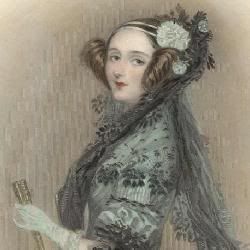Ada Lovelace Day!

Today is Ada Lovelace Day! I've blogged about the brilliant proto-software engineer before Daughter of absentee father, the mad, bad, and dangerous to know, Lord Byron, she was able to describe and conceptualize software for Charles Babbage's computing engine, before the concepts of software, hardware, or even Babbage's own machine existed! She foresaw that computers would be useful for more than mere number-crunching. For this she is rightly recognized as visionary - at least by those of us who know who she was. She figured out how to compute Bernouilli numbers with a Babbage analytical engine. Tragically, she died at only 36.
In honour of her, Ada Lovelace Day is an international day of blogging to draw attention to women excelling in technology. Almost 2000 people have pledged to blog about a women in technology, to help remedy the fact that women in technology and their "contributions often go unacknowledged, their innovations seldom mentioned, their faces rarely recognised."

So apart from Ada Lovelace herself, I thought I would tell you about another, historic, under-appreciated figure: Hedy Lamarr. It's not often one gets to talk about a Hollywood star/scientist and innovator (as well as mother), but this woman could do it all. Austrian, of Jewish heritage, she worked as an actress in film, until she married. Though her arms-manufacturer husband was part Jewish, he was a Nazi-sympathizer which infuriated her. She escaped from Europe where in 1937, by disguising herself as her maid. She came to Hollywood and made 18 films in 9 years. Meanwhile she was working with her neighbour, avant garde composer George Antheil and experimenting with automated control of instruments. Together, the two submitted the idea of a Secret Communication System in June 1941 and were granted a patent (U.S. Patent 2,292,387). This early version of frequency hopping* used a piano roll to change between 88 frequencies and was intended to make radio-guided torpedoes harder for enemies to detect or jam.
They were ahead of their time and the mechanical technology did not exist for decades. "It was not implemented in the USA until 1962, when it was used by U.S. military ships during a blockade of Cuba, after the patent had expired. Neither Lamarr nor Antheil (who died in 1959) made any money from the patent. Perhaps owing to this lag in development, the patent was little-known until 1997, when the Electronic Frontier Foundation gave Lamarr an award for this contribution." [wikipedia]
The frequency-hopping idea lives on in modern spread-spectrum communication technology - a basis for a lot of wireless communications. It's also popular in my field; geophysical electromagnetic researchers often transmit pseudo-random binary sequences (PRBS) into the earth to get a spread in frequencies and take advantage of the wider bandwidth (which means more information about a larger array of different depths below the earth's surface - different frequencies penetrate to different depths).
"Lamarr wanted to join the National Inventors Council, but she was told that she could better help the war effort by using her celebrity status to sell War Bonds. She once raised $7,000,000 at just one event." [wikipedia]
So there you go.
I write about these late, great women inventors, not to say that women in technology were extraordinary figures from the past, but rather to highlight that crucial innovations have been made by women for a long time, and that even when they had the good fortune to also have fame, fortune and beauty, as well as brilliance and innovation, they remained in the shadows.
If you want a living local hero, my favorite is Ursula Franklin. Definitely one of my heroines. Maybe I'll blog about her next....
I am so going to do a lino block print of Countess Lovelace.
Oh, and check out this lengthy feministing post about a lot of great more contemporary women in technology.